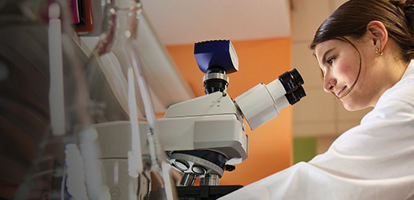Cutaneous lymphoma, or lymphoma of the skin, is a type of cancer that originates in the lymphocytes, a type of white blood cell found in the skin.

What is cutaneous lymphoma?
Cutaneous lymphoma is a rare form of lymphoma, which is a cancer of the lymphatic system. The lymphatic system is a network of vessels, tissues, and organs that help fight infection, maintain bodily fluid balance, and absorb fats in the body. There are various types of cutaneous lymphoma that can affect the skin and other parts of the body. Your AHN dermatologist and care team have experience in treating the different types of cutaneous lymphoma and are here to help you in your understanding your diagnosis and treatment plan.
Primary cutaneous lymphoma
Primary cutaneous lymphoma (PCL) originates directly in the skin, meaning it doesn't spread from another location in the body. The cancer is further classified as T-cell or B-cell based on the subtype or lymphocyte immune cells involved. It is a relatively rare type of cutaneous lymphoma, and the prognosis depends quite widely on a person’s other health factors.
What is cutaneous T-cell lymphoma?
Cutaneous T-cell lymphoma (CTLC), commonly called mycosis fungoides, is a rare form of cancer affecting the outer layers of the skin. Cutaneous T-cell lymphoma does not come from too much time in the sun, however. The condition occurs when white blood cells (lymphocytes) start growing out of control. Early detection is key in successful treatment of cutaneous T-cell lymphoma.
AHN offers one of few cutaneous T-cell lymphoma programs in western Pennsylvania. This means you are not only going to be seen by experts in the field, but also experts who see you as both a person and a patient who needs treatment tailored to your specific diagnosis.
What is cutaneous B-cell lymphoma?
B-cell lymphoma originates from abnormal B-cells, another type of white blood cell located in the skin that is responsible for antibody production. B-cell lymphoma is less common than other types of lymphomas and treatment plans are tailored to a patient’s specific needs and the lymphoma subtype.
Secondary cutaneous lymphoma
Secondary cutaneous lymphoma happens when lymphoma occurs in another organ first, and then spreads to the skin. It is commonly associated with Non-Hodgkin lymphoma and the symptoms can vary depending, but can generally appear as skin lesions, rashes, or redness.
Skin Cancer Center of Excellence
The AHN Skin Cancer Center of Excellence is at the forefront of delivering state-of-the-art treatment for cutaneous lymphoma. No other skin cancer center in the area has the technology, care, and compassion that AHN provides to its patients.
Why choose AHN for cutaneous lymphoma treatment?
At the AHN Cancer Institute, you’re never alone. We see you and your specific needs. We’re here to listen and deliver treatment that is:
- Personalized: Our skilled team of dermatologists, oncologists, pathologists, and surgeons work together to offer the latest targeted, minimally invasive surgeries or therapies pinpointed to the type of cutaneous lymphoma you have.
- Patient-centric: Our Navigation Team helps coordinate appointments, answers questions about symptoms and treatment options, and provides support if you need to travel. We help lift the burden of travel logistics, so your focus is on treatment and getting better.
- Compassionate: Cancer treatment is a stressful time. Our compassionate team of caregivers is devoted to improving your quality of life, helping you understand treatment options, and keeping you comfortable every step of the way. You have a dedicated care team who is there to help you through. And our robust cancer support services help you live the best quality of life during treatment.
- Collaborative: Your treatment team works together to identify the right treatment for you, whether it’s surgery, chemotherapy, medical oncology, or radiation therapy. Your team is in your corner to determine what will work best for you.
Cutaneous lymphoma symptoms and signs
Having regular skin checks with a dermatologist and getting regular preventive care from your primary care provider are crucial in identifying cutaneous lymphoma symptoms. Symptoms can vary depending on the type and stage of the lymphoma, so it’s important to talk with your doctor about any changes you notice. Common signs include:
- Skin lesions: Patches, plaques, nodules, or tumors on the skin.
- Itching: Often a prominent symptom, especially in the early stages.
- Redness: Affected areas may become red or inflamed.
- Scaling: The skin may become scaly or flaky.
- Swelling: Lymph nodes in the affected area may become swollen.
- Diagnosis: Diagnosis usually involves a skin biopsy, followed by further tests to determine the specific type of lymphoma. The disease is typically very slow growing and evolving. Multiple studies have shown patients typically undergo at least three biopsies over several months, or even years, before a diagnosis is confirmed. This cancer can look very similar to benign rashes such as eczema.
Cutaneous lymphoma risk factors
While the exact cause of cutaneous lymphoma is unknown, several factors are thought to increase the risk of developing this type of cancer. Talking with your doctor about these risk factors and your personal health history is critical in early diagnosis.
Factors that increase your chance of cutaneous lymphoma include:
- Age: Cutaneous lymphoma is more common in older adults, with the average age of diagnosis being around 60 years old.
- A weak immune system: If you have HIV/AIDS, have received an organ transplant, or have an autoimmune disorder, you are at greater risk for developing cutaneous lymphoma.
- Genetics: Having a family history of lymphoma (particularly cutaneous lymphoma) or certain genetic mutations (such as those in the TP53 gene) increases your risk factors.
- Environmental factors: Exposure to certain chemicals — such as arsenic, agent orange exposure pesticides, and herbicide — or to ionizing radiation — such as from medical treatments or nuclear accidents — can affect your chances of developing cutaneous lymphoma. Certain medications: Some medications, such as immunosuppressants used after organ transplantation can increase the risk of developing the disease.
Cutaneous lymphoma screening and diagnosis
The prognosis for cutaneous lymphoma varies depending on the type and stage. Regular screening, especially for those at higher risk is important. Your doctor can help determine what screening looks like for you.
Common screening options include:
- Skin biopsy: A small sample of skin is taken and examined under a microscope.
- Blood tests: A blood draw can be used to check for cancerous cells in the blood.
- Imaging tests: CT scans or MRI scans, may be used to assess the extent of the lymphoma in the body.
Find AHN cancer screening dates, locations and eligibility near you.
Diagnosing your cutaneous lymphoma
Your doctor will ask about your symptoms, family history of cancer, and any relevant medical conditions. They will examine your skin, lymph nodes, and other areas to assess the extent of the disease. Tests are performed to get a whole picture of your whole health. Each cancer case is different, and your care and treatment plan are unique to your needs. Whatever tests or screenings are needed, know that your AHN care team is here to find answers.
Skin biopsy
A skin biopsy is the most important diagnostic tool in determining a cutaneous lymphoma diagnosis. In a biopsy, a sample of skin is taken and examined under a microscope to identify cancerous cells. There are different types of biopsies, but all are done using anesthetic, so you stay as comfortable as possible while the doctor is getting what they need for an accurate diagnosis.
Types of biopsies include:
- Punch biopsy: A small, round piece of skin is removed using a special tool.
- Excisional biopsy: A larger area of skin is removed, often including the entire lesion.
- Shave biopsy: A thin layer of skin is shaved off.
Other diagnosis tests
Depending on your symptoms and history, there are additional tests that include but are not limited to:
- Blood tests: May be used to check for elevated white blood cell counts or other abnormalities.
- Microscopic examination: A pathologist examines the biopsy sample to identify the type of lymphoma cells present.
- Imaging tests: These may include CT scans or PET scans and are used to assess the extent of the disease.
- Lymph Node Biopsy: May be performed if lymph nodes are enlarged to confirm involvement by lymphoma.




Types and stages of cutaneous lymphoma
Cutaneous lymphomas are a diverse group of cancers that affect the skin. They are classified based on the type of lymphocytes (white blood cells) involved and how the disease has progressed in the body.
Primary cutaneous lymphoma
Primary cutaneous lymphoma (PCL) is classified based on the type of immune cell involved, primarily T-cells or B-cells. This distinction is crucial for understanding the disease’s behavior, treatment options, and prognosis. Your AHN doctor and care team will perform the necessary tests to understand the type and prognosis.
Cutaneous T-cell lymphoma
Cutaneous T-cell lymphoma (CTCL) is a type of non-Hodgkin lymphoma, a cancer that affects the lymphatic system. In CTCL, the cancer cells are a type of white blood cell called T-cells, and they primarily affect the skin. In the early stage, CTCL can show up as red, scaly, or bumpy itchy patches of skin. Later stages can show symptoms as skin tumors or ulcers, and/or swollen lymph nodes.
Mycosis fungoides
Mycosis fungoides (MF) is the most common type of cutaneous lymphoma diagnosed. It is characterized first by patches of itchy, red skin that progresses to plaques (flat, white, or silver lesions) and tumors (appearing as pink, red, or translucent bumps) on the skin. It progresses slowly and can be treated effectively in its early stages.
- Patch stage: Flat, scaly patches.
- Plaque stage: Raised, thickened patches.
- Tumor stage: Large, tumor-like growths.
- Erythrodermic stage: Widespread, red, scaling skin.
Sézary syndrome
Sézary syndrome (SS) is a more aggressive form of cutaneous T-cell lymphoma that spreads more across the skin, results in enlarged lymph nodes, and blood abnormalities. This type of cutaneous lymphoma may be treated similarly to mycosis fungoides, but is often more aggressive.
Sézary syndrome is characterized by:
- Widespread, red, scaling, thickened skin (erythroderma) that occurs on the entire body, but can be worse on the hands, feet, and scalp.
- Enlarged lymph nodes.
- High levels of Sézary cells (abnormal T cells) in the blood. This can cause an eyelid condition called ectropion, which causes an outward eyelid protrusion resulting in chronic tearing and chronic, potentially dangerous dry eyes.
Other subtypes of cutaneous T-cell lymphoma
While mycosis fungoides (MF) and Sézary syndrome (SS) are the most well-known, there are several other, rarer subtypes of cutaneous T-cell lymphoma (CTCL).
- Pagetoid reticulosis: This subtype has a distinctive pattern of skin involvement, often appearing as isolated and small, reddish-brown, scaly patches or plaques. This type usually progresses slowly but it can sometimes evolve into a more aggressive form of CTCL, such as MF.
- Primary cutaneous anaplastic large cell lymphoma: This subtype is a more aggressive form of CTCL that can involve the lymph nodes and other organs. It typically shows up as a pink or red nodule or cluster of nodules.
- Cutaneous large cell transformation: This subtype is a rare, aggressive form of CTCL that develops from MF or SS. A tumor, sometimes ulcerating, develops with a long-standing patch or plaque of CTCL.
- Cutaneous T-cell lymphoma, unspecified: Sometimes lymphomas don’t fit into the other categories and are labeled unspecified. This is often due to the skin cancer being a secondary manifestation of a systemic lymphoma.
- Small-medium pleomorphic T-cell lymphoma: While typically a nonaggressive subtype of CTCL, it usually appears as small bumps or spots on the skin that are typically confused for long-standing bug bites or pimples.
Cutaneous B-cell lymphoma
Cutaneous B-cell lymphoma is a type of lymphoma that primarily affects the skin. It’s a rare form of non-Hodgkin lymphoma, a type of cancer that originates in the lymphatic system The lymphatic system includes the lymph nodes, spleen, bone marrow, and thymus. The cancer originates from B-cells, a type of white blood cell that plays a role in the immune system function. The cancer originates in the skin, not the result of it spreading from another part of the body.
Types of cutaneous B-Cell lymphoma
There are several types of cutaneous B-cell lymphoma, including:
- Primary cutaneous follicle center lymphoma (PCFCL): The most common type, often appearing as nodules or plaques on the skin.
- Primary cutaneous marginal zone lymphoma (PCMZL): Can present as nodules, plaques, or even tumors on the skin.
- Primary cutaneous diffuse large B-cell lymphoma (PCDLBCL): A more aggressive type that can spread quickly.




Secondary cutaneous lymphoma and secondary cutaneous leukemia
Secondary cutaneous lymphoma and secondary cutaneous leukemia occurs when lymphoma originating in other parts of the body spreads to the skin. It can be any type of lymphoma, including:
- Hodgkin lymphoma
- Non-Hodgkin lymphoma
- Leukemia
Stages of cutaneous lymphoma
Given the wide range of unique skin cancer types that fall under a cutaneous lymphoma diagnosis, the stages vary greatly as well. The stages are not always clear-cut, and there can be variations in how they are applied. The staging system is used to guide treatment decisions. Your doctor will help you understand your cutaneous lymphoma diagnosis and tailor your treatment plan to your individual needs.
The TNMB system is widely used to stage cutaneous lymphoma and is based on:
- T (Tumor): Describes the size and extent of the tumor in the skin.
- N (Nodes): Indicates whether the lymphoma has spread to lymph nodes.
- M (Metastasis): Refers to whether the lymphoma has spread to other parts of the body (metastasis).
- B (Blood): An additional factor added for Sézary syndrome to measure the number of lymphoma cells in the blood.




Common cutaneous lymphoma stages
Mycosis fungoides (MF) and Sézary syndrome (SS) are staged similarly. SS is related to MF, but the difference is that SS includes Sézary cells in the blood.
- Stage IA: Patches of skin lesions, usually less than 10 cm in diameter. Less than 5% Sézary cells in the blood.
- Stage IB: Plaques (raised, scaly patches) or tumors, usually less than 10 cm in diameter. Lymph nodes are not affected. Sézary cells 5% or more in the blood.
- Stage IIA: Plaques or tumors larger than 10 cm in diameter. Lymph nodes are not affected.
- Stage IIB: Extensive skin lesions, including erythroderma (widespread redness and scaling of the skin). Lymph nodes are not affected.
- Stage IIIA: Skin lesions and erythroderma may be present. Involvement of one or more lymph nodes on the same side of the body as the skin lesions.
- Stage IIIB: Any T, involvement of lymph nodes on both sides of the body or in the chest.
- Stage IIIC: Any T, involvement of lymph nodes in the neck, armpits, or groin.
- Stage IVA: The cancer has spread to other organs, also called distant metastases.
Cutaneous lymphoma treatment
If you notice any unusual skin changes, it’s crucial to consult a dermatologist or your primary care provider for proper diagnosis and treatment. Early detection and treatment are essential for better outcomes.
AHN has years of experience, which helps us tailor treatments to meet your unique needs. Your personalized care plan may include any of the following treatments.
Skin-directed therapies
Skin-directed therapies are treatments we apply to the surface of your skin. These may include:
- Steroids: These medications block chemical reactions within your body that cause abnormal swelling. Steroids are often creams you rub into your skin.
- Topical retinoids: Similar to retinoids used in acne treatment, these medications are modified versions of vitamin A and are able to inhibit cancerous immune cells in the skin from replicating and spreading.
- Topical chemotherapy: We prescribe other creams with cancer-fighting drugs to stop cancer cells from growing.
- Phototherapy: Uses ultraviolet A or B energy to safely and effectively treat lymphoma in the skin. This can be performed in the office or with a home unit that’s prescribed by your doctor.
Systemic treatment
If the cancer does not respond to skin-directed therapies, we may recommend systemic treatments. These treatments circulate through the body to target and eliminate cancer cells and include:
- Chemotherapy: This is delivered by a skilled oncologist who monitors the dosage to ensure your body responds well to the medicine and treatment.
- Radiation therapy: Breakthroughs in radiation therapy allow for targeted treatments to destroy cancer cells.
- Extracorporeal photopheresis: Performed in a cancer treatment center, this uses an external machine to treat the blood/blood cells with phototherapy. It is typically used in patients where the cancer has affected the blood—such as with Sezary syndrome.
Ongoing monitoring
Your AHN care team stays in regular contact with you to make sure treatments are working. Monitoring also helps us detect any changes in your symptoms. Then, we can adjust treatments if necessary, based on your response.
When you first start treatment, we may see you as often as once a month. As you begin feeling better, you may only need follow-up visits a few times a year. The follow-up appointments are based on your needs and prognosis and are tailored to what you need.
Contact us
Call the Hope Line at (412) 578-HOPE (412) 578-4673 to connect with a nurse navigator or schedule an appointment.
Book a screening
Screenings let us find cancer early when it’s most treatable. Schedule a skin cancer screening near you during a weekday or during a Saturday screening time.
Second opinions
If you have cancer, you have a team of oncology specialists ready to review your medical records and offer you a second opinion. After completing their review, they’ll talk with you about your goals to determine a course of treatment that’s right for you. To get started, fill out our Second Opinion Request form. A nurse navigator will contact you within the next 24 to 48 hours to discuss next steps and schedule.

